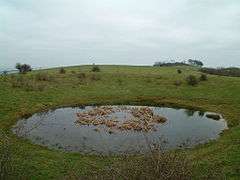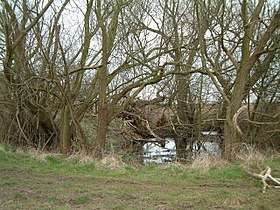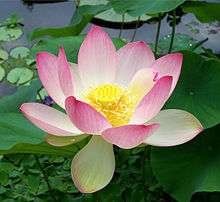Dew pond

50°53′47″N 0°23′23″W / 50.896293°N 0.389756°W
A dew pond is an artificial pond usually sited on the top of a hill, intended for watering livestock. Dew ponds are used in areas where a natural supply of surface water may not be readily available. The name dew pond (sometimes cloud pond or mist pond) is first found in the Journal of the Royal Agricultural Society in 1865.[1] Despite the name, their primary source of water is believed to be rainfall rather than dew or mist.[2]
Construction

They are usually shallow, saucer-shaped and lined with puddled clay, chalk or marl on an insulating straw layer over a bottom layer of chalk or lime.[4] To deter earthworms from their natural tendency of burrowing upwards, which in a short while would make the clay lining porous, a layer of soot would be incorporated[5] or lime mixed with the clay.[6] The clay is usually covered with straw to prevent cracking by the sun[6] and a final layer of chalk rubble or broken stone to protect the lining from the hoofs of sheep or cattle.
A method of constructing the base layer using chalk puddle was described in The Field 14 December 1907. A Sussex farmer born in 1850 tells how he and his forefathers made dew ponds:
| “ | The requisite hole having been excavated, the chalk was laid down layer by layer, while a team of oxen harnessed to a heavy broad-wheeled cart was drawn round and round the cup shaped hole to grind the chalk to powder. Water was then thrown over the latter as work progressed, and after nearly a day of this process, the resultant mass of puddled chalk, which had been reduced to the consistency of thick cream, was smoothed out with the back of a shovel from the centre, the surface being left at last as smooth and even as a sheet of glass. A few days later, in the absence of frost or heavy rain, the chalk had become as hard as cement, and would stand for years without letting water through. This old method of making dew ponds seems to have died out when the oxen disappeared from the Sussex hills, but it is evident that the older ponds, many of which have stood for scores of years practically without repair, are still more watertight than most modern ones in which Portland cement has been employed. [3] | ” |
If the pond's temperature is kept low, evaporation (a major water loss) may be significantly reduced, thus maintaining the collected rainwater. According to researcher Edward Martin, this may be attained by building the pond in a hollow, where cool air is likely to gather, or by keeping the surrounding grass long to enhance heat radiation.[7] As the water level in the basin falls a well of cool, moist air tends to form over the surface, restricting evaporation.[8]
History

The mystery of dew ponds has drawn the interest of many historians and scientists, but until recent times there has been little agreement on their early origins. It was widely believed that the technique for building dew ponds has been understood from the earliest times, as Kipling tells us in Puck of Pook's Hill.[9] The two Chanctonbury Hill dew ponds were dated, from flint tools excavated nearby and similarity to other dated earthworks, to the neolithic period. Landscape archaeology too seemed to demonstrate that they were used by the inhabitants of the nearby hill fort (probably from an earlier date than that of the surviving late Bronze Age structure) for watering cattle.[10][11] A more prosaic assessment from Maud Cunnington, an archaeologist from Wiltshire, while not ruling out a prehistoric origin, describes such positive interpretations of the available evidence as no more than “flights of fancy”.[12] A strong claim to antiquity may, however, be made for at least one Wiltshire dew pond: A land deed dated 825 CE mentions Oxenmere (51°22′33″N 1°50′54″W / 51.375960°N 1.848221°W) at Milk Hill, Wiltshire, showing that dew ponds were in use during the Saxon period.[12][13] The parliamentary enclosures of the mid eighteenth to mid nineteenth centuries caused many new upland ponds to be made, as access to traditional sources of drinking water for livestock was cut off.[14] The naturalist Gilbert White noted that during extended periods of summer drought the artificial ponds on the downs above his native Selborne, Hampshire, retained their water, despite supplying flocks of sheep, while larger ponds in the valley below had dried up.[15] Later observations demonstrated that during a night of favourable dew formation a typical increase in water level of some two or three inches was possible.[10]
There is equal controversy on the means of replenishment of dew ponds. Experiments conducted in 1885 to determine the origin of the water found that dew forms not from dampness in the air but from moisture in the ground directly beneath the site of the condensation: dew, therefore, was ruled out as a source of replenishment.[5] Other scientists have pointed out that the 1885 experiments failed to take into account the insulating effect of the straw and the cooling effect of the damp clay: the combined effect would be to keep the pond at a lower temperature than the surrounding earth and thus able to condense a disproportionate share of moisture.[10] In turn these conclusions were disproved in the 1930s, when it was pointed out that the heat-retaining quality of water (its thermal capacity) was many times greater than that of earth and therefore the air above a pond in summer would be the last place to attract condensation. The deciding factor, it was concluded, is the extent of the saucer-shaped basin extending beyond the pond itself: the large basin would collect more rainfall than a pond created without such a surrounding feature.[16]
Dew ponds are still common on the downlands of southern England, the North Derbyshire and Staffordshire moorlands and in Nottinghamshire.
Measuring of dew production
At the dew pond Helmfleeth in the municipality Poppenbüll (Peninsula Eiderstedt in Schleswig-Holtstein, Germany), In situ measurements of the evaporation and condensation were taken. For this reason, meteorological measuring instruments and a floating evaporation pan after Brockamp & Werner (1970) were used.[17] These measurements proved the dew formation on the basis of temperature changes and the weather conditions.[18][19] The dew pond Helmfleeth is part of the water supply of marsh areas and is used until today.[20]
Reproductions of historical dew ponds
In 2014, the traditional technique was verified by means of modern building material at reproductions of dew ponds in East Friesland. In this context, various techniques were tried in two terrestrial hollows. Commercially available PVC-film was used for the sealing and foam glass gravel for the insulation. The construction was carried out by craftsmen and the climatological analysis by Werner and Coldewey.[21]
Cultural references to dew ponds
The nursery rhyme Jack & Jill may refer to a dew pond at the peak of a hill rather than a well.[22]
See also
References
- ↑ Oxford English Dictionary: dew-pond
- ↑ Mayhew, Susan (2004). A Dictionary of Geography: Dew Pond (3 ed.). Oxford, England: Oxford University Press. ISBN 0-19-860673-7.
- 1 2 Martin (1915: 96)
- ↑ Brooks, Alan; Agate, Elizabeth (1976). Waterways and Wetlands. Doncaster: British Trust for Conservation Volunteers. ISBN 0-946752-30-3.
- 1 2 Johnson, Walter (1908). Folk Memory Or the Continuity of British Archaeology. Oxford, England: Oxford University Press.
- 1 2 Martin (1915: 84–85)
- ↑ Martin (1915: 133-135; 159)
- ↑ Martin (1915: 160)
- ↑ "...the Flint Men made the Dewpond under Chanctonbury Ring."
- 1 2 3 Hubbard, Arthur John; Hubbard, George (1905). Neolithic Dew Ponds and Cattleways. London: Longman.
- ↑ "Chanctonbury Ring". Prehistory. Steyning Museum. 2005. Retrieved 2008-04-14.
- 1 2 Cunnington, Maud Elizabeth (1934). An Introduction to the Archæology of Wiltshire from the Earliest Times to the Pagan Saxons. Devizes, England: George Simpson and Co.
- ↑ "Dew ponds". Wiltshire Community History. Wiltshire Council. Retrieved 22 May 2011.
- ↑ Whitefield, Patrick (2009). The Living Landscape: How to Read and Understand It. East Meon, England: Permanent Publications. p. 265. ISBN 978-1-85623-043-8.
- ↑ White, Gilbert (1788). The Natural History of Selborne. London: Benjamin White and Son.
- ↑ Pugsley, Alfred J (1939). Dewponds in Fable and Fact. London: Country Life Ltd.
- ↑ Brockamp, B.; Werner, J. (1970). "Ein weiterentwickeltes Verdunstungsmessgerät für Kleingewässer (als Beitrag zur hydrologischen Dekade der UNESCO)". Meteorol. Rdsch. 23 (2): 53–56.
- ↑ Coldewey, W. G.; Werner, J.; Wallmeyer, C.; Fischer, G. (2012). "Das Geheimnis der Himmelsteiche - Physikalische Grundlagen einer historischen Wasserversorgung im Küstenraum". Schriften der DWhG. 20 (2): 315–329.
- ↑ Werner, J.; Coldewey, W. G.; Wallmeyer, C.; Fischer, G. (2013). "Der Tauteich Helmfleeth im St. Johannis-Koog, Gemeinde Poppenbüll - Messungen und Berechnungen des Wasserhaushalts 2010". Jahrbuch "Zwischen Eider und Wiedau 2013": 1–10.
- ↑ Meier, D.; Coldewey, W. G. (2012). "Wasserversorgung in den Nordseemarschen von der römischen Kaiserzeit bis zur frühen Neuzeit". Schriften der DWhG. 20 (1): 249–260.
- ↑ Werner, J.; Coldewey, W. G.; Wesche, D.; Schütte, H.; Schütte, F.; Fähnders, H.; Neumann, R. (2016). "Studien der Wasserbilanz an zwei modernen Nachbauten historischer Tauteiche an der Nordseeküste". Schriften der DWhG: 349–369.
- ↑ "1662: Jack and Jill - explain xkcd". www.explainxkcd.com. Retrieved 2018-05-21.
External links
Articles
Images
How to build dew ponds
- Catch and Collect the Dew in a Pond, Simple instructions on how to build a dew pond.
Bibliography
| Wikimedia Commons has media related to Dew ponds. |
- Blundell, E (1909). "Dewponds". Standard Encyclopedia of Modern Agriculture.
- Allcroft, A. Hadrian (1908). Earthwork of England, Chapter 8, Dewponds. Macmillan. pp. 265–286.
- Clutterbuck, J.C. 1865 vol. 1 pp. (1865). "Prize Essay on Water Supply". Journal of the Royal Agricultural Society of England. 1 2nd series: 271–287.
- Martin, Edward Alfred (1915). Dew-ponds: history, observation, and experiment. London: Werner Laurie. OCLC 505154175. (Note: link is 1907 ed.)
- Johnson, Walter (1908). Folk-memory: or, The continuity of British archaeology. Oxford: Oxford. pp. 295–318.
Journal articles
- Beckett & Dufton (May 11, 1935). "Collection of Dew on Roofs". Nature. 135 (3419): 798–9. doi:10.1038/135798b0.
- Walford, E. (October 1924). "The Great Dewpond Myth". Discovery. V: 245.
Dewponds in specific locations
- Allcroft, A. Hadrian (1924). Downland Pathways. Methuen.
- Wills, Barclay (1989). The Downland Shepherds. Alan Sutton.
- Farey, John (1811). General View of Agriculture and Minerals of Derbyshire.
- Pope, A. (1912). Some Dewponds in Dorset, Dorset County. Chronicle Office.
- Brentnall & Carter (1932). The Marlborough County. Oxford University Press. pp. 57, 58.
- Becket, Arthur (1949). The Spirit of the Downs (8th ed.). Methuen.
- Sussex Geology. Arthur & Co. 1932.
Further reading
- Sharan, Girja (2006). Dew harvest : to supplement drinking water sources in arid coastal belt of Kutch. New Delhi, Ahmedabad: Centre for Environment Education, Foundation Books.
- Pugsley, Alfred John (1939). Dewponds in fable and fact,. London: Country Life Ltd.
- Hubbard, Arthur John; George Hubbard (1905). Neolithic dew-ponds and cattle-ways. Longmans, Green and Co.
- Cox, Evelyn Cox (1978). The Great Drought of 1976. Hutchinson, Readers Union Group.
